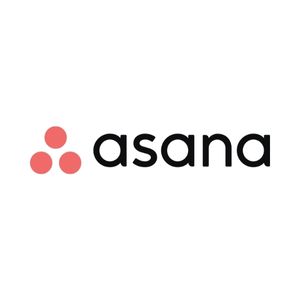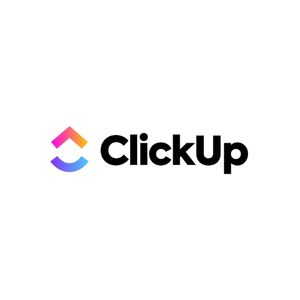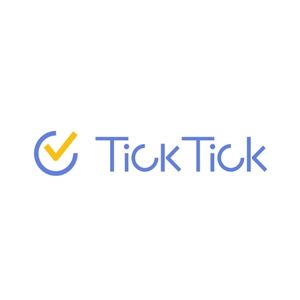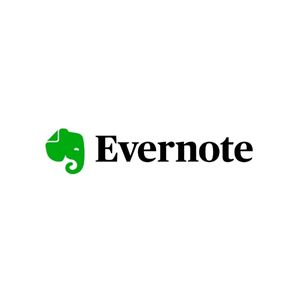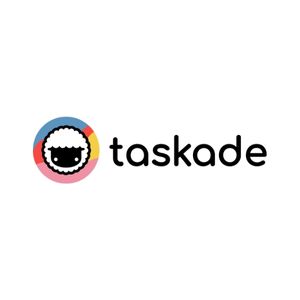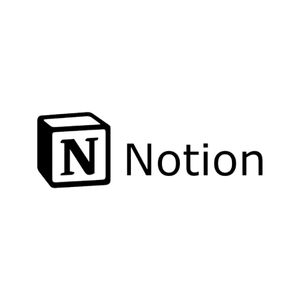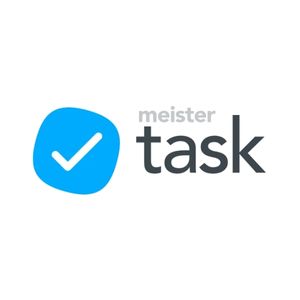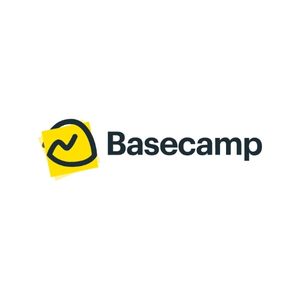When it comes to business, proper organization is key.
Today, important organization tools like Todoist help create a nice balance for you and your team to organize projects and other business affairs.
Todoist truly stands as one of the best task management tools on the market, but it’s not the only one.
Numerous Todoist alternatives may fit better for you and your team, including Asana, our number one alternative for Todoist.
- Best Todoist Alternatives: Our Top 3 Options [Ranked & Reviewed] (Overview)
- The Best Todoist Alternatives at a Glance
- An Overview of Todoist
- Best Todoist Alternatives: Our Top 3 Options [Ranked & Reviewed]
- The Best Free Todoist Options
- Notable Mentions: Other Alternatives to Todoist
- Even More Options To Check Out
- Other Alternative Roundups (Similar to Todoist)
- Frequently Asked Questions
- Wrapping Up
Best Todoist Alternatives: Our Top 3 Options [Ranked & Reviewed] (Overview)
We’ve included an overview of our top picks below. For detailed information on each pick, scroll down.
- Asana: Our Pick
- ClickUp: Runner-Up
- Google Keep: Budget Pick
- WorkFlowy
- Trello
- TickTick
- Evernote
- Taskade
- Notion
- Meistertask
- Basecamp
The Best Todoist Alternatives at a Glance
Before we dive into the details of each alternative to Todoist, here’s a basic overview of our conclusions.
What Is the Best Alternative to Todoist?
Personally, out of all the alternative task management software, Asana stands as the best alternative to Todoist.
Asana focuses its effort on task management and group work.
While it is more expensive than Todoist, Asana provides more features that truly show how much impact a productivity application can have on teams.
What is the Best Free Alternative to Todoist?
WorkFlowy is the best free alternative to Todoist, as it does everything you need in a personal management tool at no extra cost.
If you want more value or features out of your WorkFlowy software, you can upgrade for more features, but for most users, the free plan is enough.
An Overview of Todoist
For those who don’t know what Todoist is, here’s a brief overview of what you can expect from them as a management software tool.
What is Todoist?
Todoist is a productivity app that helps you manage and track current projects.
Todoist is one of the best productivity tools because of its simplistic nature and accessibility.
Where Does Todoist Excel?
Todoist excels in affordability and organization.
Its features are great for solo entrepreneurs and small teams.
It is an all-in-one software tool, and it shows.
For those who need to manage projects, Todoist covers nearly every aspect of project organization and provides all the tools you need to successfully manage your workload.
Other task management tools tend to fall short where Todoist succeeds.
Todoist has a few weak points in the features that it offers, making it a true all-rounder.
Where Does Todoist Fall Short?
While working on this Todoist review, we found that though Todoist is an all-rounder task management tool, it doesn’t surpass other tools in terms of features.
Todoist, while still an amazing task management software, doesn’t have all the support necessary for users who take on robust projects with big teams.
For example, task management software like Asana provides its users with multiple ways of viewing and organizing their projects so teams can find the best method of organization to fit their project needs.
Todoist does offer more than just Kanban boards, but it still has its limits.
Best Todoist Alternatives: Our Top 3 Options [Ranked & Reviewed]
When deciding the best alternatives to Todoist, I considered price, features, and reliability.
Here is the primary choice, including the runner-up and a budget alternative.
Asana: Our Pick
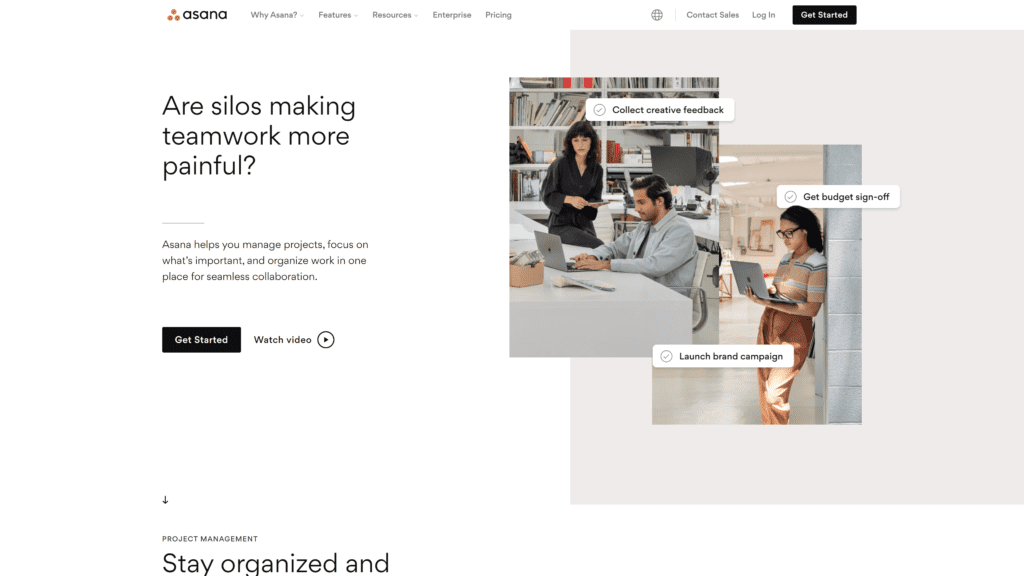
Asana is the top choice as the best alternative to Todoist.
While Asana leans towards collaborative features, it provides enough utility for multipurpose use and functions as an amazing tool for small and large teams.
Key Features of Asana
Here are some important key features that Asana brings to the table.
- Workflow builder: The Asana workflow builder enables you to organize tasks in a systematic way to speed up the general process.
- Automation: Asana offers various features that allow for process automation, including your automation method. You directly pick and choose these rules to customize your experience to fit your organizational needs.
- App Integration: The app does allow third-party integration to improve your Asana experience. Asana can fully integrate with most Google applications and even popular CRM tools.
- Reporting: Asana includes intuitive reporting features that you can view on your dashboards. You can customize and edit how Asana presents data to you and design amazing graphs and charts to improve your experience.
- Timeline: One of Asana’s most useful features is its timeline feature. This timeline view shows arrows and dependencies to show how it will progress throughout the project’s life cycle.
Todoist vs. Asana: How They Compare
For large teams, Asana is the best alternative to Todoist.
Asana’s interface is clean and modern, along with its portfolio, reporting, and timeline features, making it a more than worthy alternative for Todoist.
Why is Asana a Great Alternative to Todoist?
Asana presents data and tasks in more ways than Todoist does.
For some users, this doesn’t matter, but for others, you’ll have an alternative viewing method to better adjust for you and your team.
Pros of Asana
Here are the main benefits you may find when using Asana as an alternative to Todoist.
- Multiple Organization Options: Asana provides you with different options to organize your tasks and projects.
- Impressive Automation Features: Asana gives you multiple ways to customize your automation and improve your team’s workflow.
- Great Communication Tools: Asana gives users access to their portfolio feature, in-app messages, and Gmail integration to improve communication across your team and clients.
Cons of Asana
Asana isn’t perfect. Some negatives hold Asana back from being the top task management tool.
- Cost: Asana is a surprisingly expensive alternative. They will charge you a minimum of $27 monthly. Alternatively, you can pay $264 annually, saving around 18% on your subscription.
- Limitations of the Free Version: Asana has a free version that limits your use of it by a large margin. For example, you’ll miss timelines, rules, and third-party integration.
- No Time Tracking Functions: While Asana does offer immense reporting features, it lacks basic time-tracking processes.
Asana Pricing
Asana has an aggressive pricing plan. You’ll have to pay for a minimum of two seats, even if you’re the sole user.
Unfortunately, this makes Asana an extremely expensive option unless you have a relatively large team.
- Basic: $0. It’s completely free.
- Premium: The premium plan is $10.99, with a minimum of $26.98 monthly for two seats.
- Business: The business plan is $30.49, with a minimum of $60.98 monthly for two seats.
- Enterprise: Flexible cost.
Can You Try Asana For Free?
There is an Asana free trial so that you can try it.
The free version has various limitations, including a lack of timeline, rules, and access to their management console.
Conclusion: Should You Choose Asana Over Todoist?
If you can afford Asana, it is the better alternative to Todoist.
Asana offers plenty to its users, and as a productivity tool, it’s on a level of its own.
Unfortunately, because of their aggressive pricing practices, choosing Asana over Todoist may not be your best bet.
Todoist is affordable and gets the job done without needing the fancy features that Asana provides.
Even so, if you have a team of five or greater, Asana is a fantastic option.
ClickUp: Runner-Up
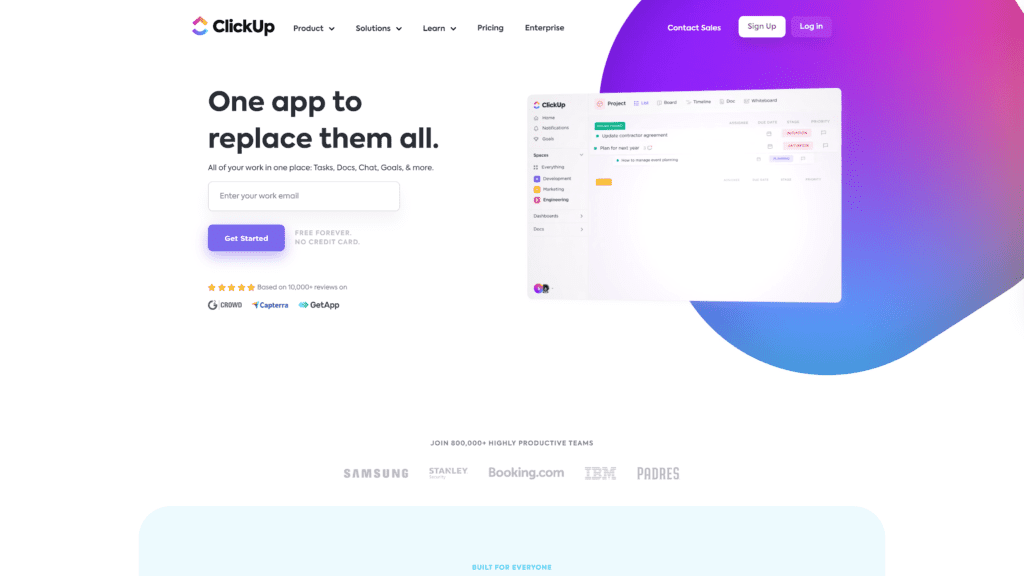
One of the best cloud-based collaborative tools on the market, ClickUp manages to provide a plethora of features while maintaining an affordable cost for small and large teams.
Key Features of ClickUp
Below are some important features you’ll want to know when using ClickUp.
- Customizable Tasks: You can add Custom Field data, assign comments as action items, and break down tasks into subtasks to help visualize your project progress.
- Nested Subtasks & Checklists: Nesting allows you to take better advantage of your indexes. You can set sub-items to better organize your projects and tasks without the clutter of multiple functions on a list.
- Templates: Users can choose from multiple design categories and themes, such as IT, marketing, and sales.
- Time Tracking: ClickUp includes time monitoring for your tasks in ClickUp and allows you to integrate other time trackers from other applications.
- Advanced Realtime Reporting: Using milestones, tracking, estimates, and dashboards, ClickUp provides an amazing reporting tool that helps innovate and improve your position on your projects and goals.
Todoist vs. ClickUp: How They Compare
ClickUp was a close second to Todoist because of its reliability.
It remains a good alternative for people who value customization, but it falls just a bit short of Asana as a productivity tool.
Todoist is the more accessible and affordable option, but ClickUp provides a premium experience for those willing to pay and learn.
Why is ClickUp a Great Alternative to Todoist?
ClickUp is a great alternative to Todoist for its time-tracking and customizable template options.
This allows you to streamline many aspects of task organization.
Pros of ClickUp
Here are a few pros to using ClickUp as your alternative to Todoist.
- Great Dashboard View: ClickUp presents reports and data in an organized, easy-to-read format.
- Intuitive Interface: While ClickUp isn’t necessarily easy-to-use, it’s easy to understand. Once you know the interface, you’ll find whatever you need whenever you need it.
- Real-Time Collaborative Features: ClickUp provides impressive features for both small and large teams to collaborate, but do so in real time. You’ll have every opportunity to share and innovate with your team through whiteboards, email, chat, proofing, and comments.
Cons of ClickUp
While ClickUp has amazing strengths, it’s not without some faults.
Here are some cons to consider when choosing ClickUp as your primary project management tool.
- Difficult Learning Curve: The ClickUp learning curve isn’t just difficult; it’s nearly impossible for beginners to get a handle on it. You’ll have to dedicate a portion of your time to utilize and understand the platform to its fullest capabilities.
- Customer Support Is Slow: ClickUp does have relatively slow customer support, and considering how difficult their software is to learn, you’ll have to be patient. Luckily, there aren’t major bugs that will disrupt your experience and need customer support’s attention.
- Heavily Reliant on Customization: One of the difficulties of ClickUp comes from its heavy reliance on customization. While this is good for some users, it can annoy others. You have to tailor your experience with the software, which may cause a delay in productivity.
ClickUp Pricing
There are various tiers that ClickUp provides. Here are their current plans and their pricing.
- Free: $0. It’s completely free
- Unlimited: The unlimited plan is $5 per monthly member (annual discount).
- Business: The business plan is $12 per monthly member (annual discount).
- Business Plus: The business plan plus is $19 per monthly member (annual discount).
- Enterprise: Customizable
Can You Try ClickUp For Free?
Fortunately, the free trial of ClickUp boasts robust features to ensure you get an impressive display of what ClickUp premium plans can provide you.
Conclusion: Should You Choose ClickUp Over Todoist?
If you appreciate customization, flexibility, and style, you should choose ClickUp over Todoist.
ClickUp is extremely rewarding for users willing to put the time and effort into learning it.
For most teams, you’ll have a less frustrating and confusing experience with Todoist.
Google Keep: Budget Pick
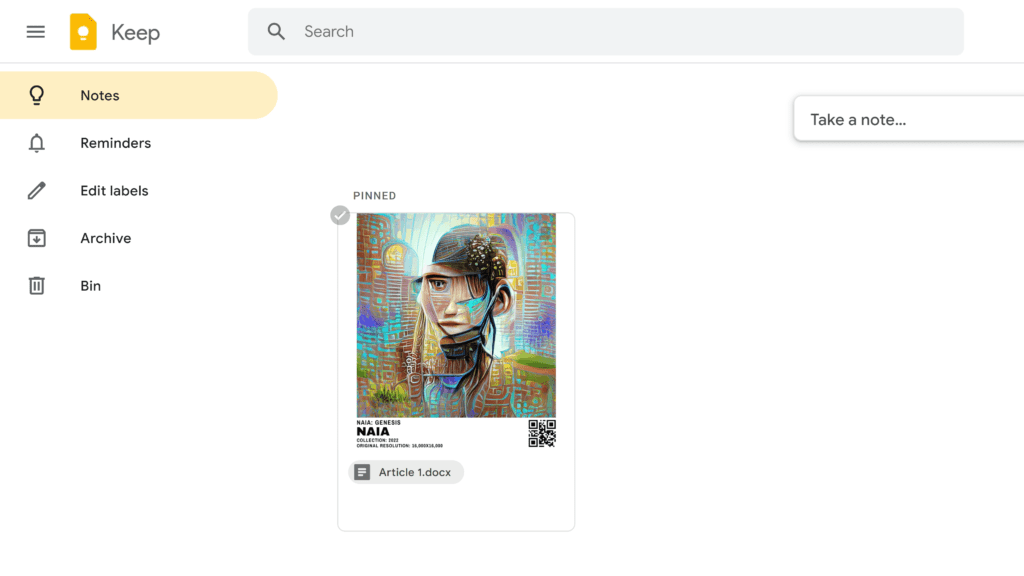
Google Keep is a budget alternative for users who don’t want to spend money on a monthly subscription.
Google Keep provides you with basic note-taking, reminders, and voice memos.
The problem with this budget option is that it comes with budget features.
You’ll get a basic organization tool, but not on the scale of Asana, ClickUp, or Todoist.
Regardless, you may want to use Google Keep to get your business or projects going.
Key Features of Google Keep
While Google Keep doesn’t have many features, it still does the job.
Here are some key features that will interest you from Google Keep.
- Notes: Most of Google Keep revolves around its note-taking capabilities. While the feature may seem simple, Google does an impressive job of providing impactful features like themes, adding images, and inviting collaborators.
- Voice Memos & Writing: If you don’t want to type out your notes, Google Keep provides voice-to-text and handwriting recognition.
- Reminders: You can schedule reminders on each of your notes. Additionally, you can use Google Chrome and Keep notification settings to inform you of those reminders when the time comes.
- Mobile Version: Most applications have a mobile version, and Google Keep is no exception. You’ll get the full browser version of Google Keep with no trade-off.
- Archive Notes & Custom Labels: For people who want to keep track of their notes, you have the option to archive all of your notes. You can also create custom labels or categories to organize notes and reminders.
Todoist vs. Google Keep: How They Compare
While Google Keep remains a great budget option, it’s not a worthy alternative to Todoist.
If you don’t want to pay extra for organization and project management features, then there is no harm in sticking with Google Keep.
It is a great option alongside your main project management tool, but it’s certainly not going to be a stand-alone option for most people.
Why is Google Keep a Great Alternative to Todoist?
The main benefit of Google Keep is that it’s absolutely free.
You won’t have to pay anything to integrate this platform into your task management.
If your budget doesn’t have room for fancy software, Google Keep may just do the job.
Pros of Google Keep
Here are some pros to using Google Keep as a reminder and management tool for personal use.
- Easy-To-Use: Google Keep is the easiest application on this list to use. It is extremely straightforward to create notes, set reminders, change themes, and finish your tasks.
- Completely Free: Google Keep provides you with all its free features. There is no premium upgrade to unlock more features.
- Works with Google Applications: Being a Google product, Google Keep does well with other Google applications.
Cons of Google Keep
Consider some of these cons when using Google Keep.
- Limited Organization Options: Google Keep forces users to be creative with how they can use the software, which will heavily limit what it can offer you in terms of productivity.
- The Storage Limit Is 15 GBs: While you can archive your Google Keep notes, there is a storage limit. You’ll find yourself reaching this limit pretty fast if you’re someone who incorporates images into your messages.
- No Longer Receiving Support and Updates: The biggest con to Google Keep is that what you have is what you’ll get. Google no longer supports Google Keep with updates or features.
Google Keep Pricing
Fortunately, Google Keep is completely free.
Can You Try Google Keep For Free?
Yes, you have free access to all of Google Keep’s features at any time.
Conclusion: Should You Choose Google Keep Over Todoist?
It’s extremely difficult to recommend Google Keep as your main productivity tool when Todoist is an option.
It would be best if you didn’t choose Google Keep over Todoist unless you have no choice.
Google Keep is the best budget option, but Todoist isn’t too expensive for most users.
The Best Free Todoist Options
Google Keep isn’t the only free option.
There are plenty of productivity tools that are free or offer free versions of their premium software.
Here are some great free options to consider.
WorkFlowy
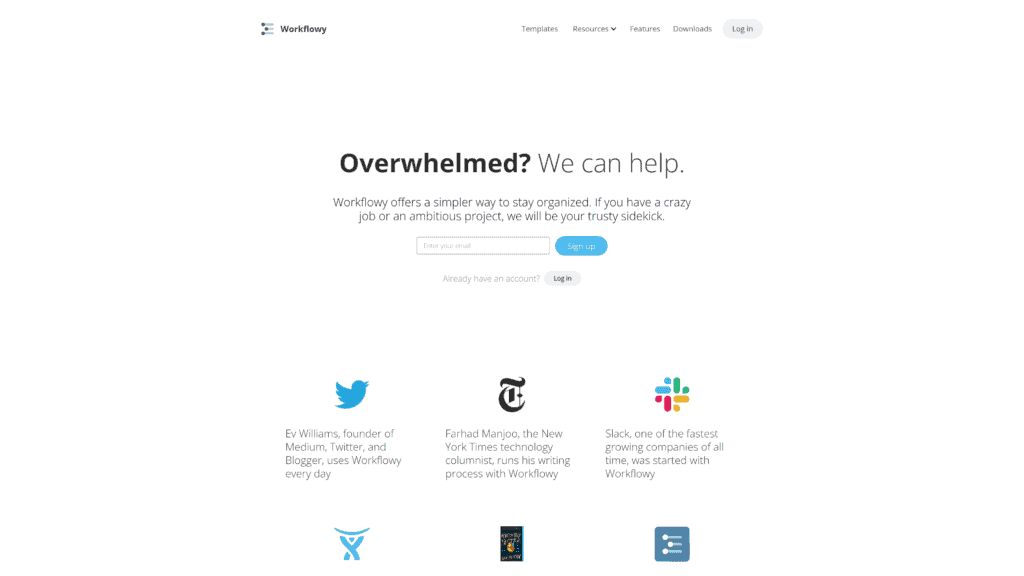
If you’re looking for a Google Keep alternative, WorkFlowy is your best bet.
While simple, WorkFlowy is an intuitive management tool that continues to receive support, unlike Google Keep.
It works well for creating lists and keeping track of what you need to complete for a certain project.
Why is WorkFlowy a Great Option?
WorkFlowy provides a free version of its software without holding much back regarding features.
It works as an amazing tool that lets you upload and share files and notes, along with infinite nesting and collaborative features.
Its easy interface makes it a great choice for any team.
Even the paid plan is pretty inexpensive at only $4.99 per month.
Drawbacks to WorkFlowy
The only real drawback to WorkFlowy is that its’ free version limits how much you can do with the application per month.
You’ll have a monthly bullet limit, a 100MB file upload cap, and basic sharing options.
Because of the restrictions, WorkFlowy may be best for small teams and projects.
Trello
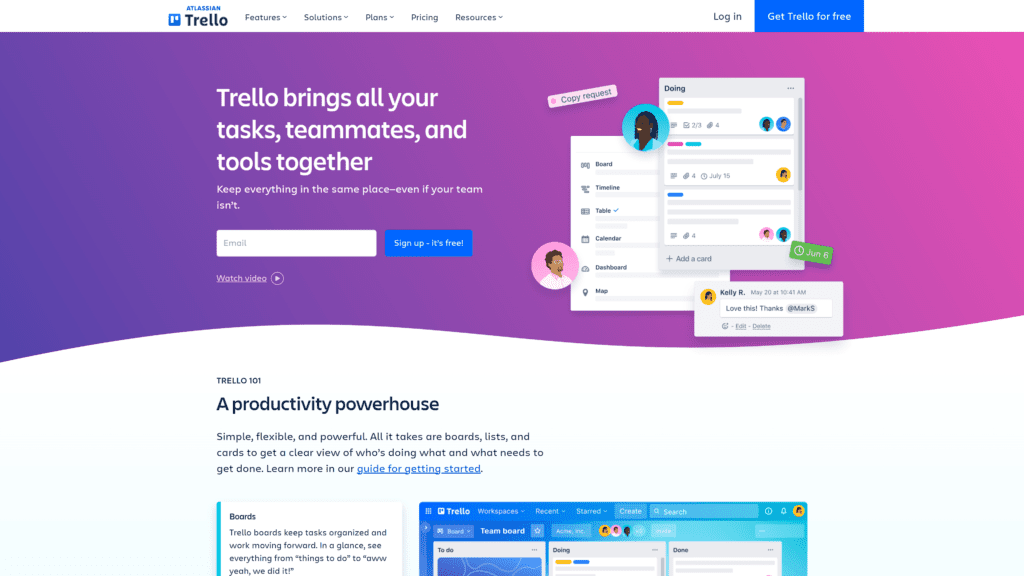
For individuals, Trello is an excellent free alternative to Todoist.
You get unlimited cards, ten boards per Workspace, and custom backgrounds and stickers.
Trello also has a mobile application and 2-factor authentication to add to your security.
Its interface is fairly simple as well, which is why many businesses like it for their project organization.
Why is Trello a Great Option?
Trello, for individuals, provides an above-average experience offering impressive productivity hacks.
Trello gives you access to most of its features with few limitations.
You get integrations, templates, and workflow automation with some restrictions.
It uses a Kanban board system, like Todoist, so if you enjoy that work method, Trello is a great choice.
Drawbacks to Trello
The main drawback of Trello is that it doesn’t serve small teams too well if you’re on its free plan.
Additionally, you lose access to advanced checklists, Timeline, Calendar, and Dashboard views.
Trello still provides more than enough functions for most users for basic use, though you have to purchase Power-Ups to access some of Trello’s best features.
Notable Mentions: Other Alternatives to Todoist
Below are some notable mentions that fell short of earning top spots on this list.
However, they’re still great alternatives to Todoist, especially if you’re looking for something simple and easy to navigate.
TickTick
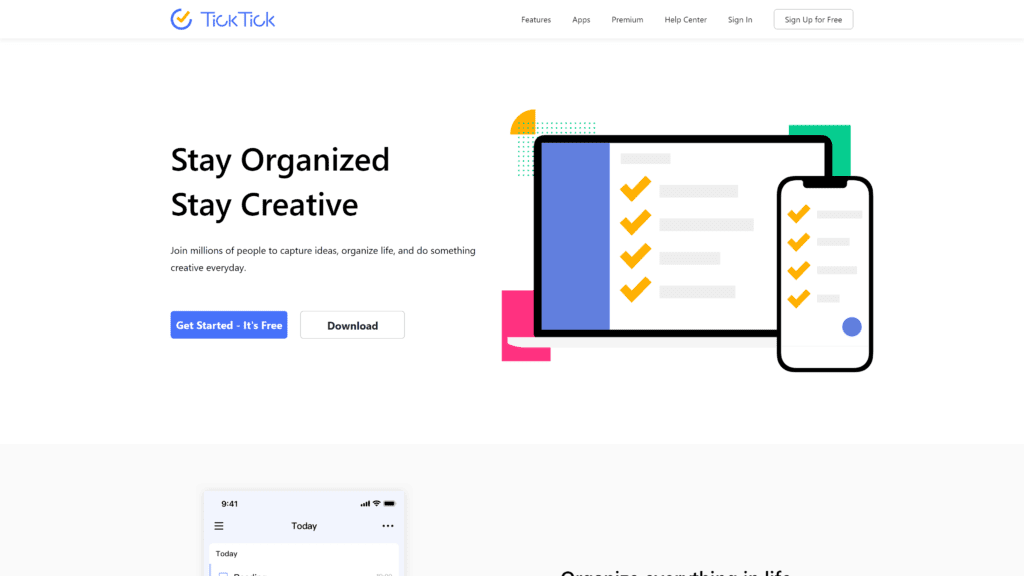
TickTick is one of the best niche collaborative productivity tools on this list.
Like Workflowy, TickTick focuses on to-do list features such as reminders, checklists, and sorting.
You can access the app using more than 10 different browsers.
Why Is TickTick a Great Option?
TickTick provides special functions for sorting your tasks, like its multi-priority feature and tag system.
They also allow you to create filters to sort your tasks and lists as you see fit.
If you like focusing on productivity, their built-in Pomodoro timer can help you keep on task with small bursts of focus.
You can also log your working hours and earn an Achievement Score.
Drawbacks to TickTick
Where TickTick falls short is in its premium plan.
TickTick doesn’t offer a free version of their application, so you can’t try it out to see if it’s for you.
While their software has impressive features that help small teams and individuals, other productivity apps, like Workflowy, do the same even with their free plans.
Evernote
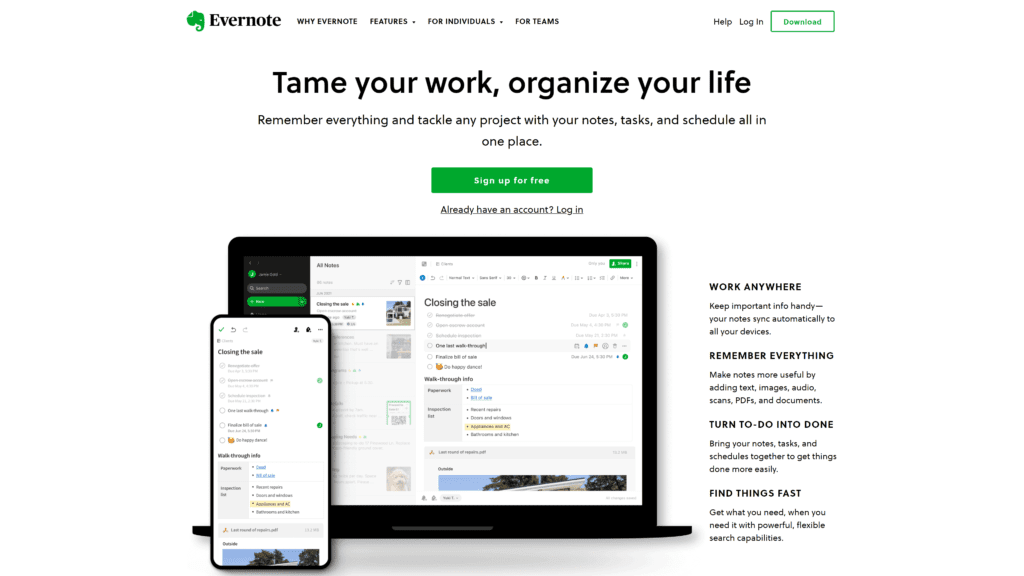
Evernote focuses on providing an intuitive and user-friendly experience across all your devices.
For many users, having an application synch across their devices is more important than the features they provide.
Evernote also boasts a free version of its software.
Why Is Evernote a Great Option?
Evernote provides advanced search tools and an intuitive interface.
Its most impressive feature allows you to clip websites and save them without worrying about ads.
The free version includes tagging and sharing features but has general restrictions on what you can do, including limiting the storage space for your notes and files.
Drawbacks to Evernote
Ultimately, Evernote’s restrictive free version and the premium price hold it back.
Many customers complain about the lack of storage space the free version provides, but if you’re willing to pay $9.99 per month, you can upgrade to 20GB in uploads per month.
Taskade
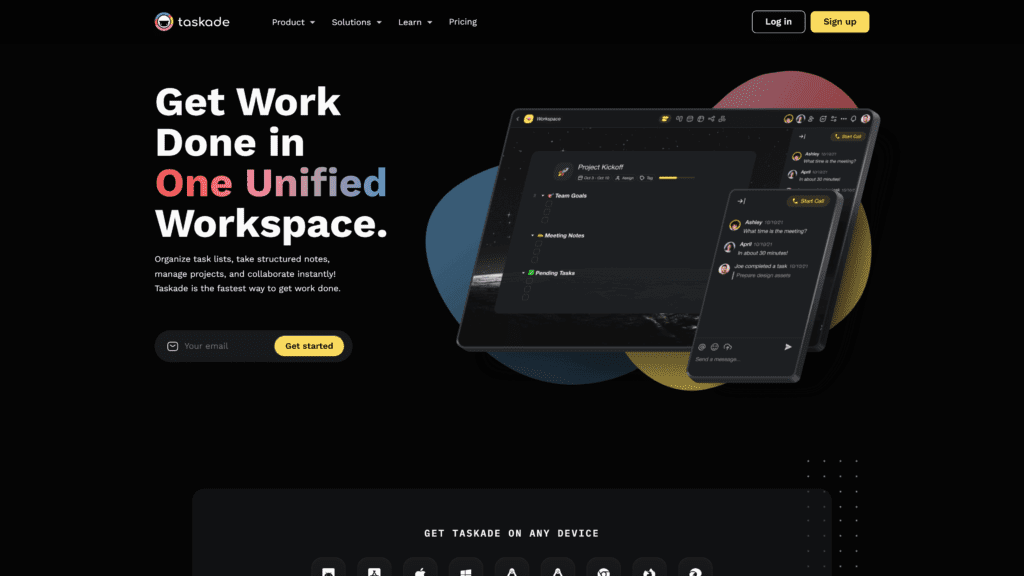
Taskade is the one project management tool on every device, including browsers and Linux.
Built with collaboration in mind, Taskade boasts features that will boost productivity for any sized team.
Why Is Taskade a Great Option?
Taskade has a free version of their application, but more impressive, they have a lifetime access license for their software.
While some of the bulk features and data amounts are excluded from the free version, you might not need the extras from the subscription.
Additionally, Taskade’s features focus on managing your team and sharing your tasks across any device with anyone.
Drawbacks to Taskade
There aren’t too many drawbacks to Taskade.
What held Taskade back was that for its price, you could get more value from other software with a similar price, like ClickUp.
Despite that, you do get plenty of features with the free version that might just be enough for you if you aren’t running a big team that needs lots of storage space.
Even More Options To Check Out
If you haven’t had enough to choose from, here are a few more task management tools that might interest you.
Notion
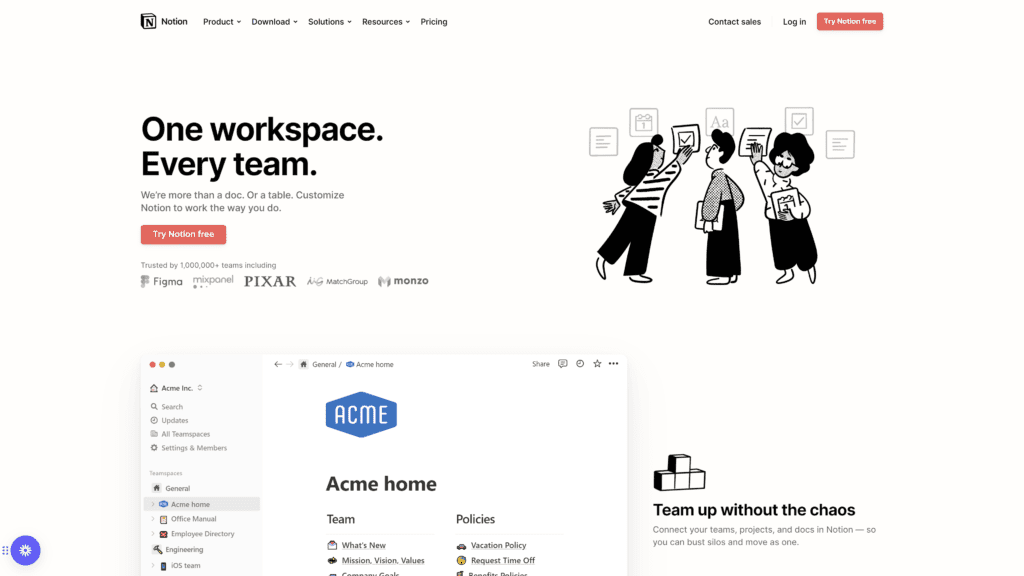
For freelancers, Notion is an amazing choice.
Notion allows users to build the workflow they want and provides impressive customization options to personalize the software to your liking.
You also have access to a modest amount of integration, including integration with Slack.
Users praise Notion for its easy access and quick search function.
Additionally, Notion users can create full databases and connect them to others.
The sharing options are lacking but still serve their purpose.
Meistertask
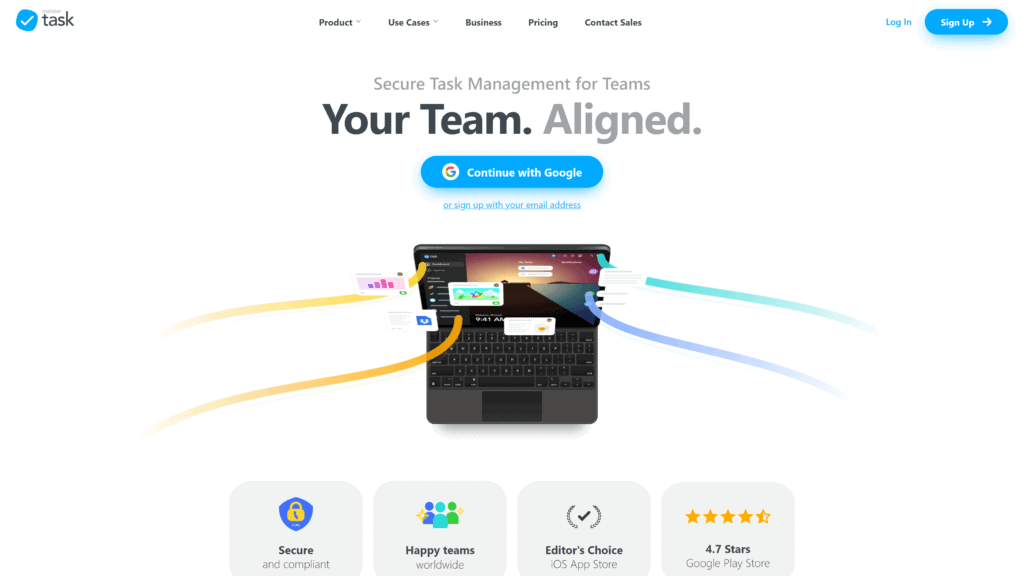
With a scheduling feature, projects, tasks, and an impressive dashboard to view it all, MeisterTask holds its own on this list.
Its core version covers most of what freelancers need to stay on track, but its hefty premium and business pricing keep it from earning more praise.
Regardless, users rave about how beautiful the software looks.
The user interface is clean, and because of this, the software becomes easy for most users to understand and navigate.
Basecamp
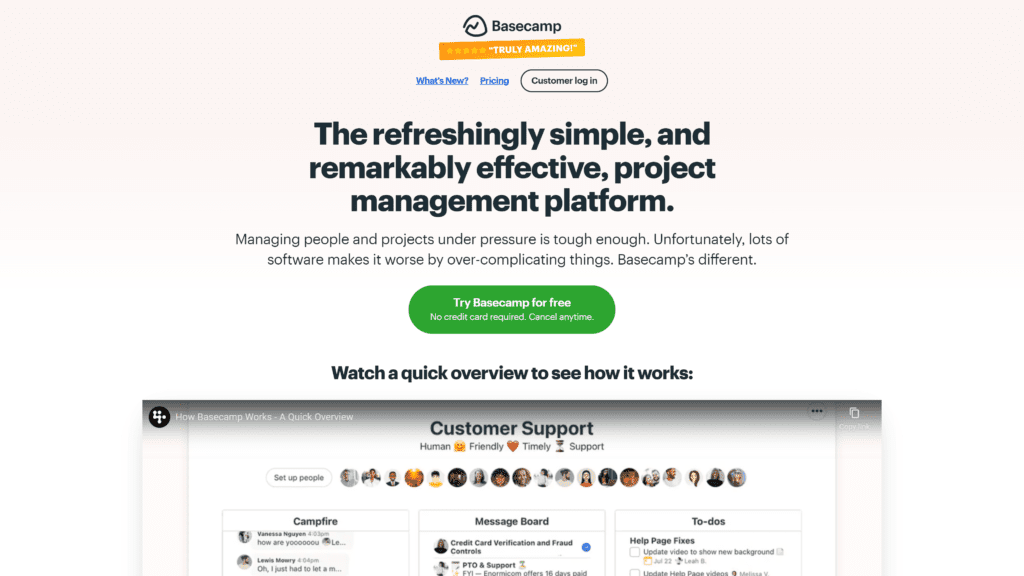
Simplicity is what Basecamp prides itself on.
Basecamp provides the best visual experience for users to easily understand their software and collaborate with their team.
Through Basecamp, you can assign, delegate, and notify when projects and tasks are complete.
For only $11 per month per user, Basecamp gives Asana a run for its money.
Unfortunately, you get a more practical collaboration tool with Asana for just a few dollars more, so Basecamp falls short of taking any top spots.
Other Alternative Roundups (Similar to Todoist)
If one of the Todoist alternatives spoke to you but wasn’t the best fit, you may be able to find the perfect solution with one of these organizational alternatives.
- Asana Alternatives: Asana is a pretty expensive option for most users, but Todoist doesn’t offer much for large teams. If you have a large group and big projects to manage, you may want to consider some Asana alternatives that will hopefully be within your budget.
- ClickUp Alternatives: Todoist doesn’t offer much in terms of personalization. If customization and personalization are important to you, we have some ClickUp alternatives that provide a similar experience to ClickUp’s personalization features with the ultra-organization of Todoist.
- Trello Alternatives: Trello is easily one of the market’s most beginner-friendly project management tools. These other Trello alternatives focus on a similar easy-to-understand mindset to quickly familiarize users with their software, making them ideal if you don’t have a lot of time to train your team to use a program.
Frequently Asked Questions
If you still don’t feel that you have enough information to decide on an organizational platform for your business, check out these frequently asked questions that may be able to ease some of your concerns.
Is Todoist the best?
When it comes to affordability, Todoist is the best option.
While it doesn’t have massive strength, it has no core weaknesses like other productivity tools on this list.
The general nature and accessibility of Todoist make it one of the, if not the best, pick for your productivity needs.
Can Notion replace Todoist?
Yes, depending on your needs, Notion can replace Todoist.
As a productivity app, Notion will provide you with the tools to manage your projects and tasks, similar to Todoist.
Wrapping Up
Todoist isn’t the only productivity tool on the market, and there are viable alternatives for those with different needs that Todoist doesn’t meet.
Todoist offers users the necessary tools, but other options can go beyond that.
Asana remains the number one alternative, as it does what Todoist does and amplifies it.
While still the more expensive option, it remains the top choice for large teams who need help organizing their members and projects.
ClickUp, however, is more affordable than both Asana and Todoist, so it may be ideal for those on a budget.

